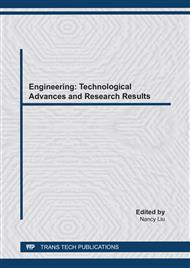[1]
UNESCO Creative Cities Network, https://en.unesco.org/creative-cities/.
Google Scholar
[2]
R. Florida, The Rise of the Creative Class, Revisited Basic Books (2012).
Google Scholar
[3]
M. Douglass, Creative communities versus the cultural economy - the vernacular city as an alternative to globopolis in Singapore (National University of Singapore, Department of Sociology, 2013).
Google Scholar
[4]
F.Z. Fahmi, S. Koster, J.van Dijk, The location of creative industries in a developing country: The case of Indonesia Cities, 59, 66–79 (2016).
DOI: 10.1016/j.cities.2016.06.005
Google Scholar
[5]
F.Z. Fahmi, P. McCann, S Koster, Creative economy policy in developing countries: The case of Indonesia Urban Studies, 1-18 (2015).
DOI: 10.1177/0042098015620529
Google Scholar
[6]
F.Z. Fahmi, P. McCann, S Koster (2015) op.cit.
Google Scholar
[7]
Y.J. Kim, Making Creative, Movement: Transformation of Urban Culture and Politics in Bandung, Indonesia Geographical Review of Japan Series B 90(1): 17–25 (2017).
DOI: 10.4157/geogrevjapanb.90.17
Google Scholar
[8]
A. Ozimek, Richard Florida Is Wrong About Creative Cities (2012) https://www.forbes.com/sites/modeledbehavior/2012/05/23/richard-florida-is-wrong-about-creative-cities/#3fa67ce4a33d.
Google Scholar
[9]
E Moretti, The new geography of jobs (Houghton Mifflin Harcourt Publishing Company, 215 Park Avenue South, New York, New York 10003, 2012).
Google Scholar
[10]
I. Resmadi, Gimmick Ridwan Kamil, Inovasi, dan Anak Muda (2015) https://geotimes.co.id/tokoh/kolom-ridwan-kamil/gimmick-ridwan-kamil-inovasi-dan-anak-muda/.
DOI: 10.26714/lensa.9.2.2019.187-200
Google Scholar
[11]
M.R. Wiryawan, Bandung as a Gimmick City (2015) https://komunitasaleut.com/2015/05/22/bandung-as-a-gimmick-city/.
Google Scholar
[12]
A.S. Ekomadyo, Revitalizing The Tradition: Global Local and CulturalEconomic Relation on Public Market Revitalization in Indonesia. International Seminar on Vernacular Settlement (ISVS) 7 (Istanbul Technical University, Turkey, 2014).
Google Scholar
[13]
A. Vltchek, Insane UN Claim: Bandung is a Creative City, (2016) https://journal-neo.org/2016/02/02/bandung-creative-city/.
Google Scholar
[14]
D. Thorsby, On the Sustainability of Cultural Capital. Research Papers from Macquarie University, Department of Economics. (2005) https://www.researchgate.net/publication/ 5165805_On_the_Sustainability_of_Cultural_Capital.
Google Scholar
[15]
R. Axelsson, P. Angelstam, E. Degerman, S. Teitelbaum, K. Andersson, M. Elbakidze, M.K. Drotz, Social and Cultural Sustainability: Criteria, Indicators, Verifier Variables for Measurement and Maps for Visualization to Support Planning. AMBIO 42:215–228 (2013).
DOI: 10.1007/s13280-012-0376-0
Google Scholar
[16]
J.I. Nassauer, Placing Nature: Culture and Landscape Ecology, (Island Press, Washington DC, 1997).
Google Scholar
[17]
K. Dovey, Becoming Places: Urbanism/ Architecture/ Identity/ Power (London: Routledge, 2010).
Google Scholar
[18]
P. Bourdieu, The Field of Cultural Production (New York: Columbia University Press. 1993).
Google Scholar
[19]
R. Florida (2012), op.cit.
Google Scholar
[20]
J.A. Schumpeter, Business Cycles: A theoretical, historical and statistical analysis of the capitalist process (New York, McGraw-Hill, 1939).
Google Scholar
[21]
P.F. Drucker, Innovation and Entrepreneurship: Practice and Principles Harper and Row, (New York, 1985).
Google Scholar
[22]
H. Etzkowitz, The Triple Helix: University–Industry–Government Innovation in Action. (New York: Routledge 2008).
Google Scholar
[23]
J. Novy, C. Colomb, Struggling for the Right to the (Creative) City in Berlin and Hamburg: New Urban Social Movements, New Spaces of Hope', International Journal of Urban and Regional Research (2012).
DOI: 10.1111/j.1468-2427.2012.01115.x
Google Scholar
[24]
M. Miles, 5 A Post-Creative City RCCS Annual Review A Selection from the Portuguese journal Revista Critica de Ciencias Sociais, 5 (2013) https://journals.openedition. org/rccsar/506.
DOI: 10.4000/rccsar.506
Google Scholar
[25]
Moreti (2012) op.cit.
Google Scholar
[26]
Novy, Colomb, (2012) op.cit.
Google Scholar
[27]
M. Csikszentmihalyi, Creativity: Flow and The Psychology of Discovery and Invention New York: HarperCollins (1997).
Google Scholar
[28]
Novy, Colomb, (2012) op.cit.
Google Scholar
[29]
P. McIntyre, Creativity and Cultural Production: A Study of Contemporary Western Popular Music Songwriting, Creativity. Rsrch. J, 20(1), 40–52, (2008).
DOI: 10.1080/10400410701841898
Google Scholar
[30]
Bourdieu, (1993) op. cit.
Google Scholar
[31]
Dovey, (2010) op.cit.
Google Scholar
[32]
Novy, Colomb, (2012) op.cit.
Google Scholar
[33]
M. Castells, The city and the grassroots: a cross-cultural theory of urban social movements Edward Arnold (London, 1983).
Google Scholar
[34]
A.S. Ekomadyo, F.A. Prasetyo, S. Yuliar, Place Construction and Urban Social Transformation: an Actor Network Theory Analysis For Creative-Kampung Phenomena in Bandung, HABITechno International Seminar: Innovation Housing and Settlement Technology. (Institute of Technology Bandung, 2013) (https://www.academia.edu/16973222/ Place_Construction_and_Urban_Social_Transformation_An_Actor_Network_Theory_Analysis_for_Creative_Kampong_Phenomena_in_Bandung).
DOI: 10.15187/adr.2020.05.33.2.19
Google Scholar
[35]
A.S. Ekomadyo, S. Yuliar, Social Reassembling as Design Strategies 5th Arte Polis International Conference and Workshop – Reflections on Creativity: Public Engagement and The Making of Place Bandung, Indonesia. Science Direct - Procedia – Soc. and Behavioral Sci. 184 (2015).
DOI: 10.1016/j.sbspro.2015.05.075
Google Scholar
[36]
A.S. Ekomadyo, T. Santri, A. Riyadi. Reassembling Traditionality and Creativity? A Study of Creative Community Movement in Cihapit Market Bandung International Conference of Architectural Education in Asia (Eduarchsia) Indonesian Islamic University, Yogyakarta, (2017).
DOI: 10.1051/shsconf/20184107006
Google Scholar
[37]
N. Cross, Designerly Ways of Knowing Design Studies Vol.3 No.4 (1982).
Google Scholar
[38]
I.B. Zainuddin, Desain, Sains Desain, dan Sains tentang Desain: Telaah Filsafat Ilmu. Article in Wacana Desain: Karya dan Pemikiran Imam Bukhori Zainuddin (ITB Press, Bandung 2011).
DOI: 10.32315/sem.1.c129
Google Scholar


